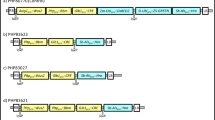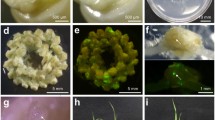Summary
The importance of cell culture conditions, including the use of feeder cells, on protoplast growth and transformation in maize (Zea mays L.) was investigated. Total GUS activity, measured two days after transformation, was five-fold higher in protoplasts cultured on feeder cells compared to those grown in the absence of feeder cells. Since the specific activity of GUS was only slightly higher in the transformed protoplasts plated over feeder cells, the stimulation in transient gene expression resulted mainly from the improved environment provided by the feeder system. For stable transformation, either PEG treatment or electroporation of protoplasts was used to introduce the neo gene. When PEG was used, over 85% of the putative transformants (resistant to kanamycin) contained the neo gene. The combination of PEG transformation and the optimized cell culture protocol using feeder cells enabled the selection of about 100 stably transformed lines per gFW of cells. Electroporation was less efficient.
Similar content being viewed by others
References
Antonelli M, Moreno M, Stadler, J (1988) Successful transfer of the chloramphenicol acetyl transferase gene to Black Mexican Sweet (BMS) protoplasts by polyethylene glycol. In: Maize Genetics Cooperation News Letter 62, pp 7–8
Callis J, Fromm M, Walbot V (1987) Introns increase gene expression in cultured maize cells. Genes and Development 1:1183–1200
Christou P, Murphy JE, Swain WF (1987) Stable transformation of soybean by electroporation and root formation from transformed callus. Proc Natl Acad Sci USA 84:3962–3966
Chu CC, Wang CC, Sun CS, Hus C, Yin KC, Chu CY (1975) Establishment of an efficient medium for anther culture of rice through comparative experiments on the nitrogen sources. Sci Si 18:659–668
Dellaporta, SL, Wood J, Hicks JB (1983) A plant DNA minipreparation: version II. Plant Molecular Biology Reporter 1:19–21
Folger KR, Wong EA, Wahl G, Capecchi MR (1982) Patterns of integration of DNA microinjected into cultured mammalian cells: Evidence for homologous recombinations between injected plasmid DNA molecules. Mol Cel Biology 2:1372–1387
Fromm ME, Taylor LP, Walbot V (1986) Stable transformation of maize after gene transfer by electroporation. Nature 319:791–793
Hauptmann RM, Vasil V, Ozias-Akins P, Tabaeizadeh Z, Rogers SG, Fraley RT, Horsch RB, Vasil IK (1988) Evaluation of selectable markers for obtaining stable transformants in the Gramineae. Plant Physiol 86: 602–606
Imbrie-Millgan CW, Hodges TK (1986) Microcallus formation from maize protoplasts prepared from embryogenic callus. Planta 168:395–401
Jefferson RA, Kavanagh TA, Bevan MW (1987) GUS fusions: β-glucuronidase as a sensitive and versatile gene fusion marker in higher plants. EMBO J 6:3901–3907
Kamo KK, Chang KL, Lynn ME, Hodges TK (1987) Embryogenic callus formation from maize protoplasts. Planta 172:245–251
Krens FH, Molendijk L, Wullems G, Schilperoort RA (1982) In vitro transformation of plant protoplasts with Ti-plasmid DNA. Nature (London) 296:72–74
Kuang V, Shamina ZB, Butenko RG (1984) Use of nurse tissue culture to obtain clones from cultured cells and protoplasts of corn. Sov Plant Physiol 30:613–620
Lee L, Schroll RE, Grimes HD, Hodges TK (1989) Plant regeneration from indica rice (Oryza sativa L.) protoplasts. Planta (in press)
Lowry OH, Rosebrough NJ, Farr AL, Randall RJ (1951) Protein measurement with the Folin phenol reagent. J Biol Chem 193:256–275
Ludwig SR, Somer D.A., Petersen WL, Pohlman RF, Zarowitz MA, Gengenbach BG, Messing J (1985) High frequency callus formation from maize protoplasts. Theor Appl Genet 71:344–350
Maniatis T, Fritsch EF, Sambrook J (1982) Molecular Cloning: A Laboratory Manual. Cold Spring Harbor Laboratory, Cold Spring Harbor, NY pp
Murashige T, Skoog F (1962) A revised medium for rapid growth and bioassays with tobacco tissue cultures. Physiol Plant 15:473–497
Nellen N, Firtel RA (1985) High-copy-number transformants and co-transformation in Dictyostelium. Gene 39:155–163
Rhodes CA, Lowe KS, Ruby KL (1988a) Plant regeneration from protoplasts isolated from embryogenic maize cell cultures. Biotechnology 6:56–60
Rhodes C, Pierce DA, Mettler IJ, Mascarenhas D, Detmer JJ (1988b) Genetically transformed maize plants from protoplasts. Science 240:204–206
Somers DA, Birnberg PR, Petersen WL, Brenner ML (1987) The effect of conditioned medium on colony formation from ‘Black Mexican Sweet’ corn protoplasts. Plant Science 53:249–256
Shillito RD, Paszkowski J, Potrykus I (1983) Agarose plating and a bead type culture technique enable and stimulate development of protoplast-derived colonies in a number of plant species. Plant Cell Rep 2:244–247
White PR (1954) The cultivation of animal and plant cells. Ronald Press, New York
Vasil V, Hauptmann RM, Morrish FM, Vasil IK (1988) Comperative analysis of free DNA delivery and expression into protoplasts of Panicum maximum Jacq. (Guinea grass) by electroporation and polyethylene glycol. Plant Cell Rep 7:499–503
Wang YC, Klein TM, Fromm M, Cao J, Sanford JC, Wu R (1988) Transient expression of foreign genes in rice, wheat and soybean cells following particle bombardment. Plant Mol Biol 11:933–939
Author information
Authors and Affiliations
Additional information
Communicated by A. R. Gould
Rights and permissions
About this article
Cite this article
Lyznik, L.A., Kamo, K.K., Grimes, H.D. et al. Stable transformation of maize: the impact of feeder cells on protoplast growth and transformation efficiency. Plant Cell Reports 8, 292–295 (1989). https://doi.org/10.1007/BF00274133
Received:
Revised:
Issue Date:
DOI: https://doi.org/10.1007/BF00274133




